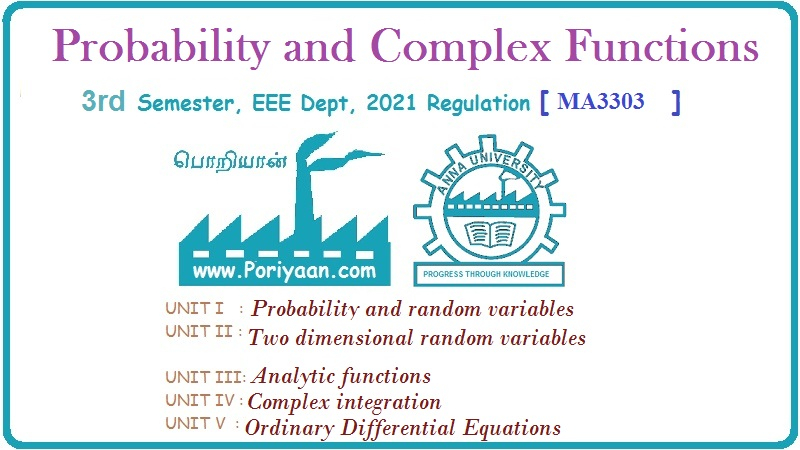Probability and complex function: Unit I: Probability and random variables
(i) Discrete random variable
A random variable whose set of possible values is either finite or countably infinite is called discrete random variable.
(a) (i) Discrete random variable
A
random variable whose set of possible values is either finite or countably
infinite is called discrete random variable.
Example
1.
Let X represent the sum of the numbers on the 2 dice, when two dice Tera are
thrown. In this case the random variable X takes the values 2, 3, 4, 5, 6, 7,
8, 9, 10, 11 and 12. So X is a discrete random variable.
2.
Number of transmitted bits received in error.
(ii) Probability mass function
If
X is a discrete random variable, then the function P (x) = P[X=x] is called the
probability mass function of X.
(iii) Probability distribution
The
values assumed by the random variable X presented with corresponding
probabilities is known as the probability distribution of X.

(iv) Cumulative distribution or Distribution function of X [for
discrete R.V]
The
cumulative distribution function F(x) of a discrete random variable X with
probability distribution P (x) is given by

(v) Properties of distribution function :
1.
F(- ∞) = 0
2.
F(∞) = 1
3.
0 ≤ F(x) ≤ 1
4.
F(x1) ≤ F(x2) if x1 < x2
5.
P(x1 < X ≤ x2) = F(x2) - F (x1)
6.
P(x1 ≤ X ≤ x2) = F
(x2) - F (x1) + P(X = x1]
7.
P(x1 < X < x2) = F (x2) - F (x1)
- P (X = x2]
8.
P(x1 ≤ X < x2) = F(x2) -F (x1) -
P (X = x2) + P(X = x1)
(vi) Results :
1.
P(X ≤ ∞) = 1
2.
P(X ≤ - ∞) = 0
3.
If x1 ≤ x2 then P (X = x1) ≤ P (X = x2)
4.
P(X > x) = 1 - P [X ≤ x]
5.
P(X ≤ x) = 1 − P(X > x)
(vii) Expected value of a Discrete random variable X.
M
Let X be a discrete random variable assuming values x1, x2,
..., xn with corresponding probabilities P1, P2,
..., Pn. Then

is
called the Expected value of X.
E(X)
is also called commonly the mean or the expectation of X.
A
useful identity states that for a function g,

(viii) The variance of a random varaible X.
It
is defined by Var(X) = E[X - E (X)]2The variance, which is equal to
the expected value of the square of the difference between X and its expected
value. It is a measure of the spread of the possible values of X.
A
useful identity is that no
Var(X)
E[X2] - [E (X)]2
The
quantity √Var (X) is called the standard deviation of X.
Probability and complex function: Unit I: Probability and random variables : Tag: : - (i) Discrete random variable
Related Topics
Related Subjects
Probability and complex function
MA3303 3rd Semester EEE Dept | 2021 Regulation | 3rd Semester EEE Dept 2021 Regulation
